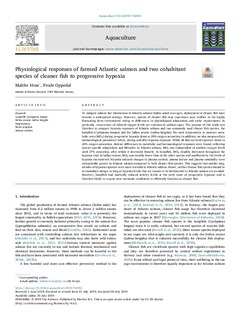| dc.description.abstract | To mitigate salmon lice infestations in Atlantic salmon (Salmo salar) sea cages, deployment of cleaner fish have become a widespread strategy. However, species of cleaner fish may experience poor welfare in the highly fluctuating farm environment owing to differences in physiological adaptations and niche requirements. In particular, occurrences of reduced oxygen levels are common in salmon cages. The purpose of this study was therefore to compare hypoxia responses of Atlantic salmon and two commonly used cleaner fish species, the lumpfish (Cyclopterus lumpus) and the ballan wrasse (Labrus bergylta). We used respirometry to measure metabolic rates (MO2) during progressive hypoxia down to 20% oxygen saturation. In addition, we also measured key haematological parameters before, during and after hypoxia exposure. While all fish survived exposure down to 20% oxygen saturation, distinct differences in metabolic and haematological responses were found, reflecting species specific adaptations and lifestyles. In Atlantic salmon, MO2 was independent of ambient oxygen levels until 27% saturation, after which it decreased linearly. In lumpfish, MO2 steadily decreased throughout the hypoxia trial. In ballan wrasse, MO2 was notably lower than in the other species and unaffected by the levels of hypoxia encountered. Hypoxia induced changes in plasma cortisol, plasma lactate and plasma osmolality were substantially greater in Atlantic salmon compared to both cleaner fish species. This suggests that similar magnitudes of hypoxia exposure were more stressful to Atlantic salmon. Hence, neither cleaner fish species should be in immediate danger as long as hypoxia levels that are known to be detrimental to Atlantic salmon are avoided. However, lumpfish had markedly reduced activity levels at the early onset of progressive hypoxia, and is therefore likely to require near normoxic conditions to efficiently function as cleaner fish. | nb_NO |
